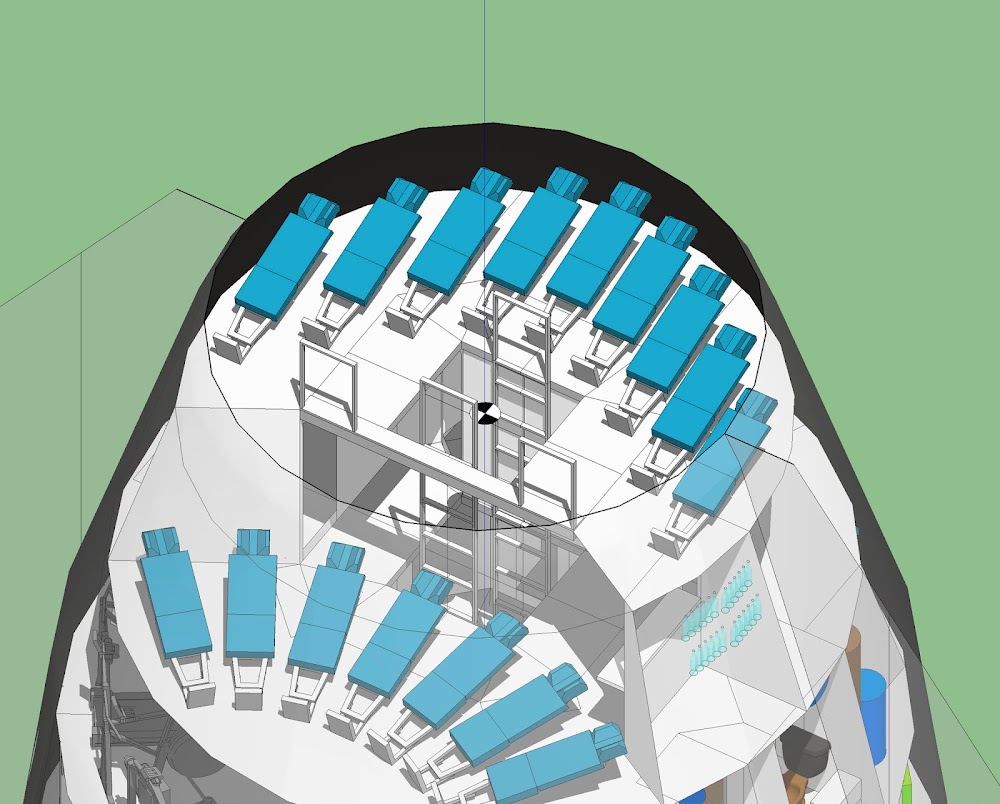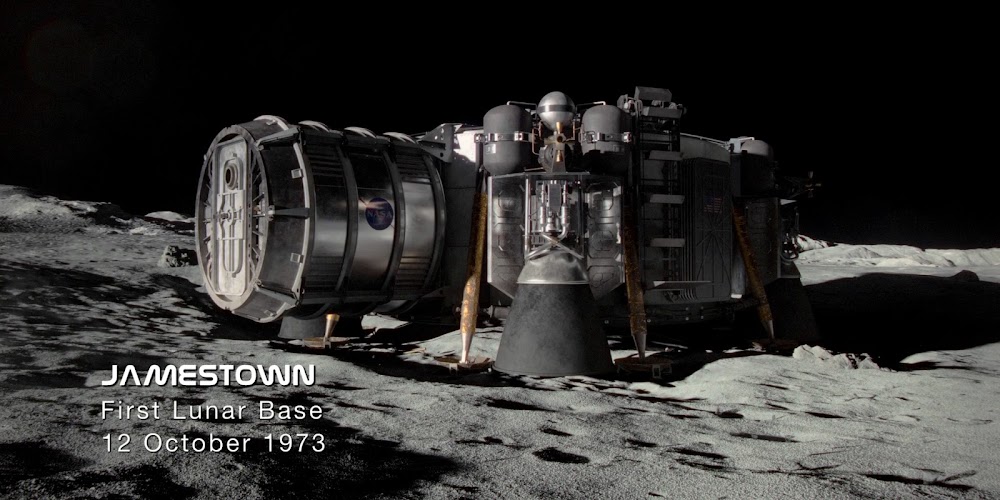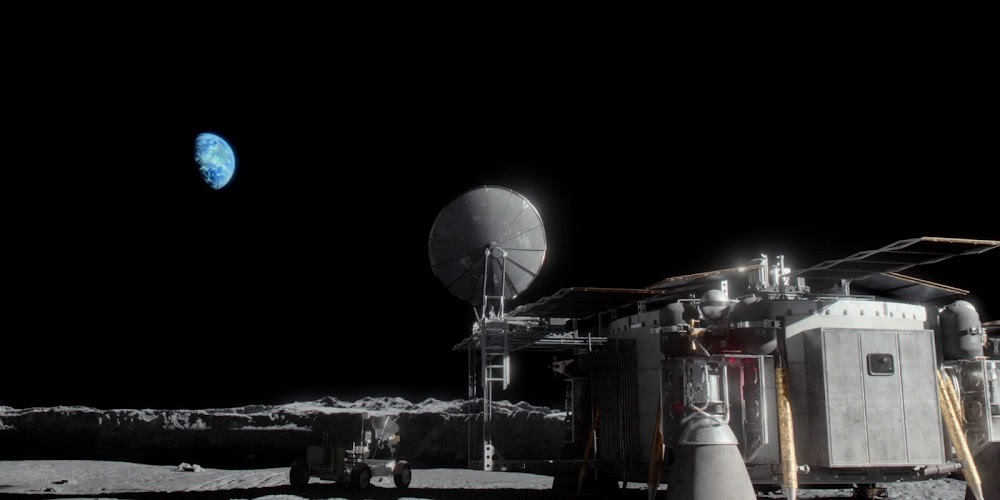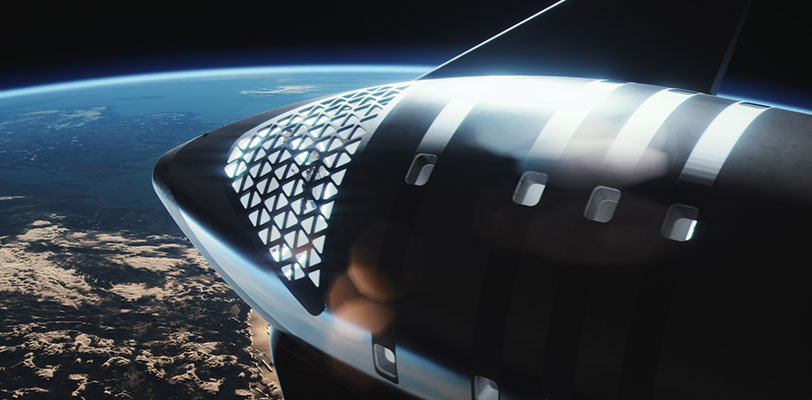Deck 8 - Observation
Thursday, April 1, 2021
SpaceX Starship interior concept for 100 passengers by Joseph Lantz
Joseph Lantz has created his concept for the interior layout of SpaceX's 100-passenger Starship (the passenger capacity goal stated by Elon Musk). Therefore this concept isn't meant for the first crew Starships on Mars used as temporary habitats for the first few years (those first Starships will have much smaler crew). The concept divides the pressurized living space into 8 decks (here shown from top to bottom) and follows a common design choice of a central stairway through all the decks.
Tuesday, March 30, 2021
Astronaut relaxing near a SpaceX Starship spaceport
Picture of the Day 30/03/2021 - Astronaut leaning against his Mars rover derived from a retro car near a SpaceX Starship spaceport by American video game concept artist Darren Bacon in collaboration with parody account Bored Elon.
Monday, March 29, 2021
Jamestown US Moon base in season 1 of "For All Mankind" TV series
For All Mankind is alternate history sci-fi TV series depicting what could have happened if the space race had never ended after the Soviet Union succeeds in the first crewed Moon landing ahead of the United States in 1969. The authors of the show speculate such an event would force US to double down on space exploration altering the Apollo program from "flags and footprints" approach to a more ambitious one with extensive infrastructure buildup on the Moon (with hints of Mars exploration in later seasons of the show). Pouring money and resources into space exploration creates an atmosphere every space nerd would have wanted to continue after the enthusiastic 1960s.
Season 1 of the series (aired in 2019) depicts events from 1969 to 1974 in the alternate timeline of For All Mankind. The series are in the middle of season 2 now depicting the alternate 1983. It was said each season of the show will jump about a decade further into the increasingly diverging reality of the show. We will feature season 2 here after it will be aired completely. So here is a collection of HD images from season 1 with a focus on US Jamestown lunar base at the rim of Shackleton Crater near the lunar South pole where water ice is discovered in 1970 (several decades earlier than in reality):
Season 1 of the series (aired in 2019) depicts events from 1969 to 1974 in the alternate timeline of For All Mankind. The series are in the middle of season 2 now depicting the alternate 1983. It was said each season of the show will jump about a decade further into the increasingly diverging reality of the show. We will feature season 2 here after it will be aired completely. So here is a collection of HD images from season 1 with a focus on US Jamestown lunar base at the rim of Shackleton Crater near the lunar South pole where water ice is discovered in 1970 (several decades earlier than in reality):
Landing of the initial Jamestown lunar base module in October 1973:
Jamestown Phase 1 US lunar base in 1974:
Sunday, March 21, 2021
Martian colonies in season 5 of The Expanse
Mars is one of the three competing powers in universe of The Expanse TV series - a political sci-fi drama set a few centuries in the future where humans have colonized the entire Solar system. Mars, governed by Martian Congressional Republic, is a militaristic and technologically advanced society of over nine billion inhabitants. Martian society had been highly mobilized towards the shared goal of terraforming Mars for over a century but in season 4 that shared goal and order of the Martian society was starting to erode as the new habitable planets beyond the rings were discovered and people realized they could build a new home there without the costly need of terraformation. That erosion continues in season 5.
In Martian scenes of season 5 the show focuses on depicting Asteria Naval Base (or Asteria NB) which is a military base and war college of the Martian Congressional Republic Navy (MCRN). Here is a collection with HD images from the Martian scenes in season 5 of The Expanse (open link in new tab to view in full resolution).
In Martian scenes of season 5 the show focuses on depicting Asteria Naval Base (or Asteria NB) which is a military base and war college of the Martian Congressional Republic Navy (MCRN). Here is a collection with HD images from the Martian scenes in season 5 of The Expanse (open link in new tab to view in full resolution).
Exterior and interior of the Asteria Naval Base:
Martian mass transit network crosses canyons on cables and runs deep under ground:
Saturday, March 13, 2021
СССР-2061 - a retrofuturistic vision of Soviet Union on Mars
Project "СССР-2061" is a community of Russian artists and writers envisioning Soviet Union in 2061 in an alternate reality. In 2011 they held their 1st arts contest asking participants to envision Soviet Union on Mars 50 years into the future. Here are some of the artworks from the contest.

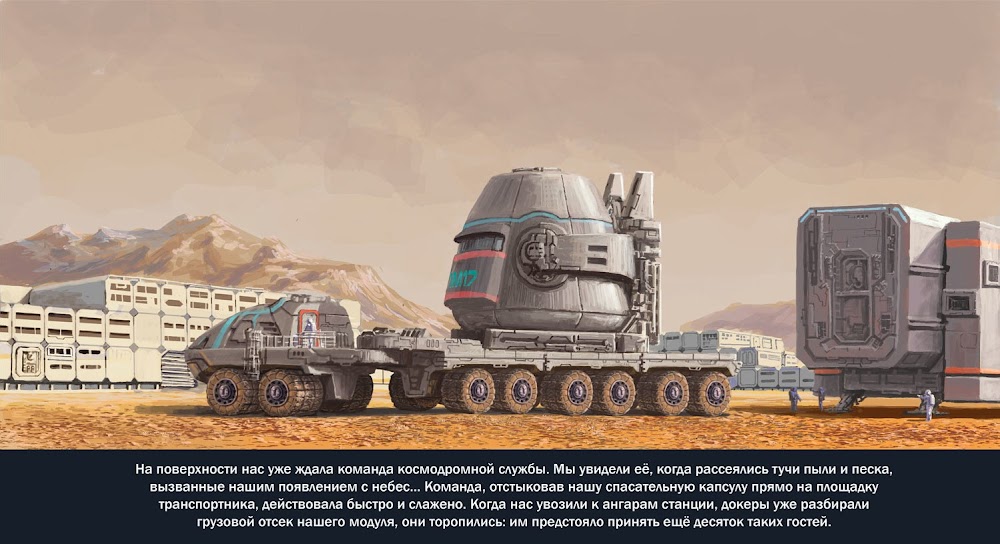

Soviet spaceport in Valles Marineris on Mars by Igor Savin:


Domed soviet colony on Mars by Grinya Lesnoy:

Thursday, March 11, 2021
SpaceX Starship landing on Mars by Kendall Dirks
Sunday, March 7, 2021
SpaceX 100+ Starship fleet arriving to Mars
Wednesday, March 3, 2021
Updated design of #dearMoon Starship (2021)
On March 3 dearMoon Project opened application process for 8 crew member spots on SpaceX's first crewed deep space mission - #dearMoon Starship flight around the Moon scheduled for 2023. Applications are open for everyone now, not just the artists as originally was planned. The applications page contains some official renders of Starship's updated design with the most visible differences being in main window design:
Tuesday, March 2, 2021
SpaceX has downselected 7 potential Mars landing sites for Starship
On September 2019 it was revealed SpaceX has selected several Starship candidate landing sites on Mars. The candidate sites were located in Southern Arcadia Planitia East of Erebus Montes and one in Phlegra Montes.
Since then SpaceX has conducted several workshops with the Mars science community to evaluate and narrow the list of candidate landing sites. All the sites must fit several criteria:
Recently an abstract with the conclusions has been published (the results of the study will be presented in two weeks, at the 52nd Lunar and Planetary Science Conference), pointing out 4 prime and 3 secondary potential Starship landing sites selected for further study and located in Phlegra Montes, Erebus Montes and Southern Arcadia Planitia:
We highlighted selected ★ prime and ★ secondary sites on the map:
Since then SpaceX has conducted several workshops with the Mars science community to evaluate and narrow the list of candidate landing sites. All the sites must fit several criteria:
- close to significant deposits of water/ice, a required resource for in situ propellant production and a consumable to support habitation;
- elevation below -2 km (with respect to the MOLA geoid) that can support the delivery of large payloads, with -3 km preferred;
- latitude must be <40° for solar power and thermal management, and closer to the equator is desirable;
- multiple separate landing locations spaced within a few km of each other, to support the multiple missions needed to grow an outpost;
- slopes should be <5° over a 10 m length scale and the chance of impacting a rock greater than 0.5 m high (1 m diameter) should be <5%;
- landing site must be radar reflective to enable measurement of the distance to the surface, and it must be load bearing to support the spacecraft at touchdown.
Recently an abstract with the conclusions has been published (the results of the study will be presented in two weeks, at the 52nd Lunar and Planetary Science Conference), pointing out 4 prime and 3 secondary potential Starship landing sites selected for further study and located in Phlegra Montes, Erebus Montes and Southern Arcadia Planitia:
- PM-1 has the lowest latitude and elevation of the Phlegra Montes sites, a clear association with LDAs (local ice deposits expressed as lobate debris aprons), well developed polygons (one of the indicators of ice-related morphologies), and has the highest SWIM (Subsurface Water Ice Mapping) score for geomorphic indicators of ice;
- AP-1 (Arcadia Planitia) appears to be one of the safest sites and has a moderate combined SWIM score for ice;
- AP-9 has the thickest ice from radar returns (of the Arcadia Planitia sites) and geomorphology indicating shallow ice. It has the highest combined SWIM score for ice, but appears slightly rocky and rough;
- EM-16 has a clear association with an LDA with nearby brain terrain and the strongest radar return for shallow ice and the highest combined SWIM score of the Erebus Montes sites;
- AP-8 (Arcadia Planitia) appears to be one of the safest sites and has the highest neutron and combined SWIM scores for ice;
- EM-15 (Erebus Montes) is associated with a prominent but less extensive LDA, has well developed polygons, nearby brain terrain and appears smooth;
- PM-7 is adjacent to lineated valley fill (attributed to glacial flow) and appears to be the safest of the Phlegra sites.
We highlighted selected ★ prime and ★ secondary sites on the map:
Friday, February 26, 2021
SpaceX Mars exploration rover concept by Alexander Svanidze
Russian game artist Alexander Svanidze has created his concept of SpaceX's Mars exploration rover (CyberRover) made by Tesla. More of his art here.
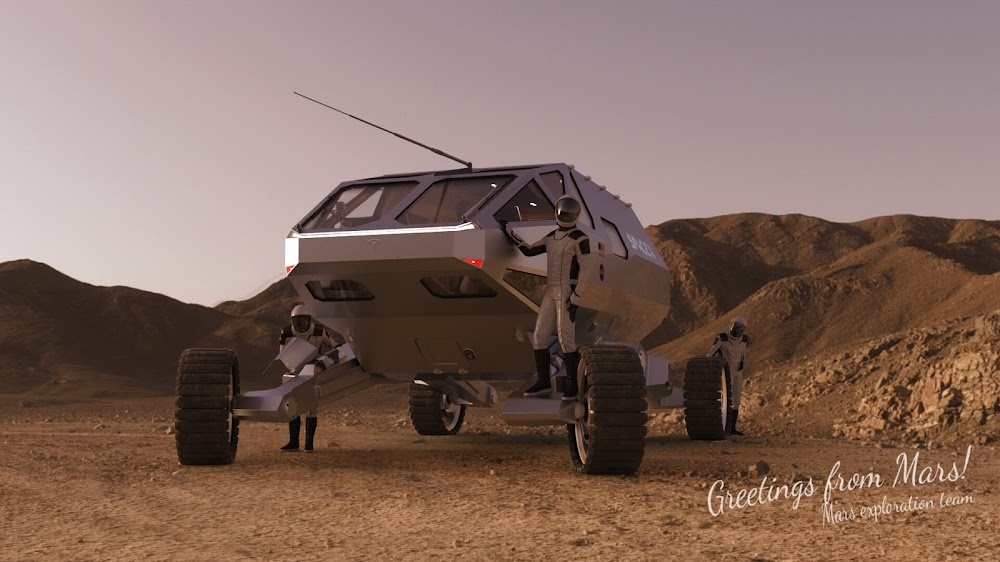

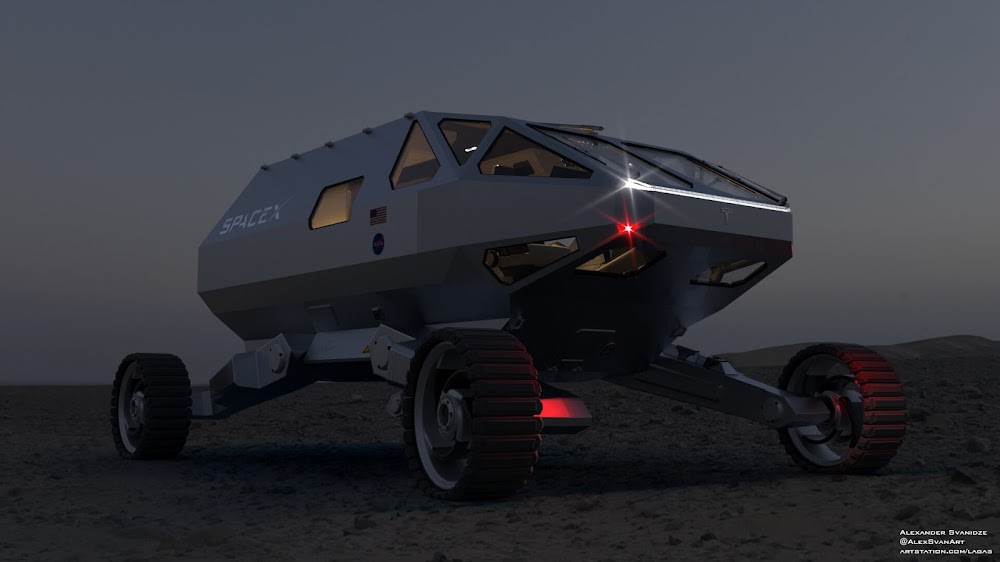
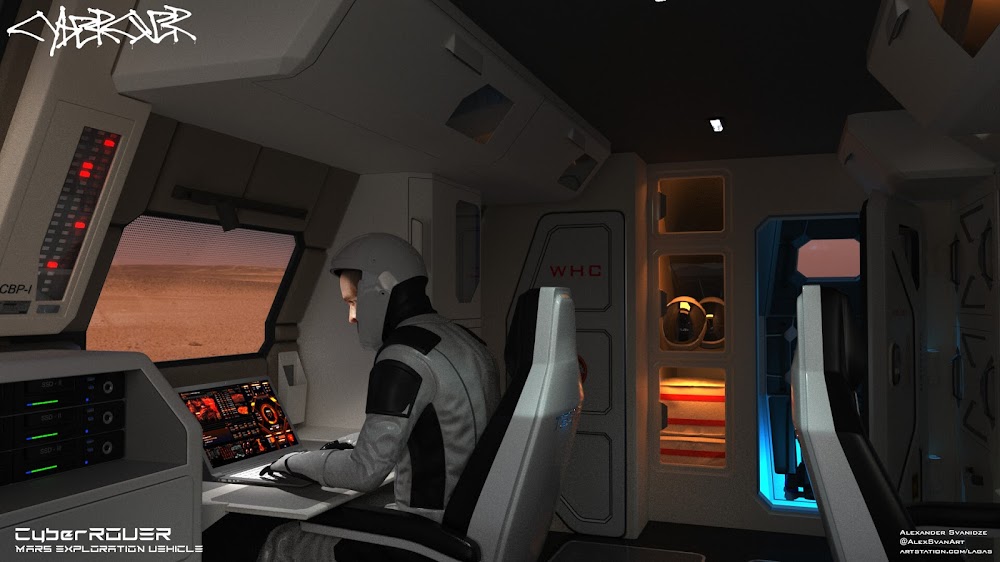




Subscribe to:
Posts (Atom)


